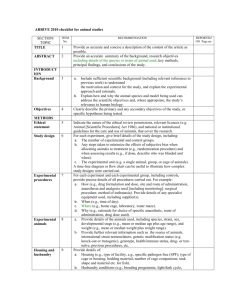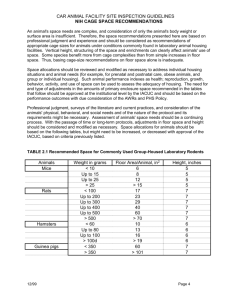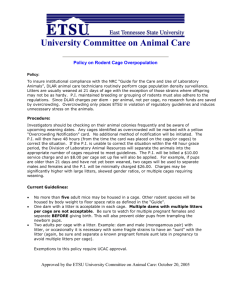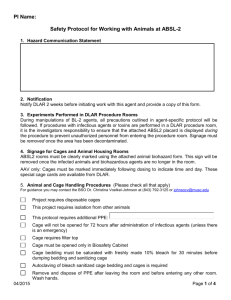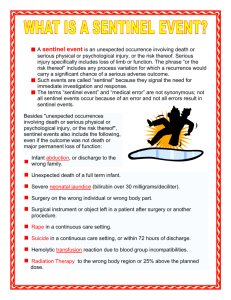Rodent Sentinel Animal Program
advertisement
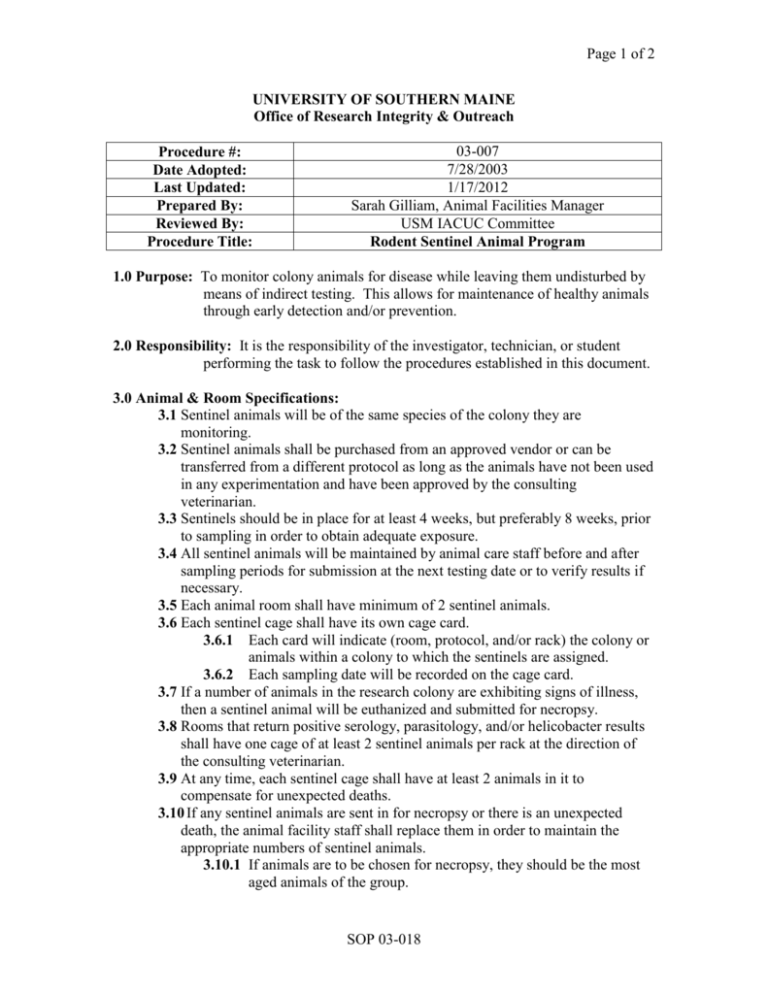
Page 1 of 2 UNIVERSITY OF SOUTHERN MAINE Office of Research Integrity & Outreach Procedure #: Date Adopted: Last Updated: Prepared By: Reviewed By: Procedure Title: 03-007 7/28/2003 1/17/2012 Sarah Gilliam, Animal Facilities Manager USM IACUC Committee Rodent Sentinel Animal Program 1.0 Purpose: To monitor colony animals for disease while leaving them undisturbed by means of indirect testing. This allows for maintenance of healthy animals through early detection and/or prevention. 2.0 Responsibility: It is the responsibility of the investigator, technician, or student performing the task to follow the procedures established in this document. 3.0 Animal & Room Specifications: 3.1 Sentinel animals will be of the same species of the colony they are monitoring. 3.2 Sentinel animals shall be purchased from an approved vendor or can be transferred from a different protocol as long as the animals have not been used in any experimentation and have been approved by the consulting veterinarian. 3.3 Sentinels should be in place for at least 4 weeks, but preferably 8 weeks, prior to sampling in order to obtain adequate exposure. 3.4 All sentinel animals will be maintained by animal care staff before and after sampling periods for submission at the next testing date or to verify results if necessary. 3.5 Each animal room shall have minimum of 2 sentinel animals. 3.6 Each sentinel cage shall have its own cage card. 3.6.1 Each card will indicate (room, protocol, and/or rack) the colony or animals within a colony to which the sentinels are assigned. 3.6.2 Each sampling date will be recorded on the cage card. 3.7 If a number of animals in the research colony are exhibiting signs of illness, then a sentinel animal will be euthanized and submitted for necropsy. 3.8 Rooms that return positive serology, parasitology, and/or helicobacter results shall have one cage of at least 2 sentinel animals per rack at the direction of the consulting veterinarian. 3.9 At any time, each sentinel cage shall have at least 2 animals in it to compensate for unexpected deaths. 3.10 If any sentinel animals are sent in for necropsy or there is an unexpected death, the animal facility staff shall replace them in order to maintain the appropriate numbers of sentinel animals. 3.10.1 If animals are to be chosen for necropsy, they should be the most aged animals of the group. SOP 03-018 Page 2 of 2 3.11 Quarantine/isolation room population: 3.10.2 A minimum of 2 sentinels shall be used for the first 10 cages of a quarantine population to be tested. 3.10.3 Another sentinel animal shall be added for each additional 5 cages in the population to be tested. 3.10.3.1 Example: for 10 cages there will be 2 animals, for 15 cages there will be 3 and for 27 cages there will be 5 and so on. 4.0 Procedure for Bedding Study: 4.1 During normal weekly cage changing, animal care personnel will reserve samples of soiled bedding from each colony animal cage. 4.2 This bedding will be added to clean cage(s) that will be used for the sentinel animals. 4.2.1 The soiled bedding will be added in a manner that the sentinel cage is not overly moist, but will allow for adequate exposure. 4.3 Method 4.3.1 A small amount of the soiled bedding from each normal colony cage will be taken and placed into a clean empty cage or mixing container. 4.3.2 Once all soiled colony cages have been sampled & changed, thoroughly mix the soiled bedding. 4.3.3 Next place about two handfuls of the soiled bedding into a clean cage with clean bedding. Make sure that the cage is not excessively wet and that approximately 1/3 to ½ of the cage contains colony-soiled bedding. 4.3.4 Gloves should be changed between mixing of bedding for each sentinel cage. 4.3.5 After the cage is prepared, then the sentinel animal cage should be changed with fresh food and water being provided to the animals. 5.0 Sampling of Sentinel Animals: 5.1 Sentinel animals shall be serology tested on a quarterly basis. Animals may be tested more frequently if there is a need to do so. 5.2 Twice a year, fecal samples from sentinel animals will be submitted for helicobacter and parasitology testing. 5.3 Serology samples will be collected fresh in accordance with SOP 03-006: Rodent Blood Collection Procedures. 5.3.1 Fecal samples will also be collected fresh from the animal by placing them in an empty cage for a short period of time. Once a fecal sample is obtained, the animal will be returned to their normal cage. Animals are NOT to remain in an empty cage for extended periods of time. 5.4 All samples, serological or fecal will be sent to Charles River Labs for testing. 5.5 Histopathology and/or necropsy will be performed at the request of the consulting veterinarian and will also be submitted to Charles River Labs. SOP 03-018
